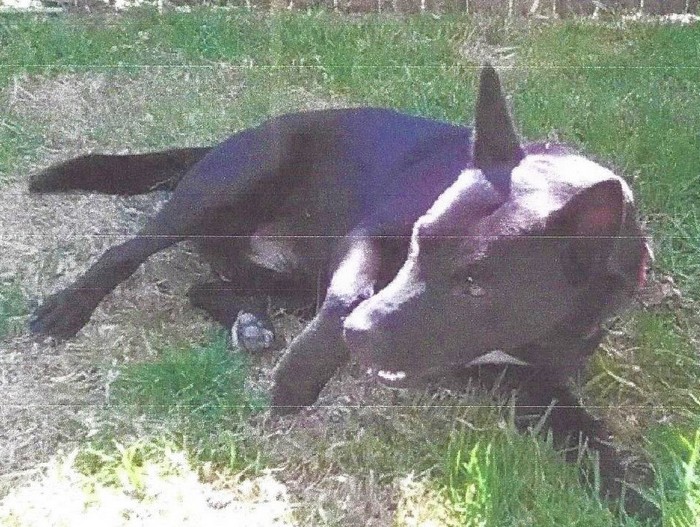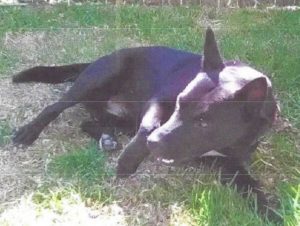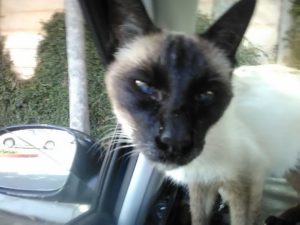XENA – Black, medium sized Shepherd mix 5 years old.
Wearing red collar with her license and tag with Xena and phone# 805-207-0235.
If you see her, please contact
Nancy Broadhead 805-207-0235
or
Cappi Patterson 805-766-5920
Category Archives: Professor Scamp Ph.D (Pretty Happy Dog)
Vol. 12, No. 11 – Feb 27 – Mar 12, 2019 – The Pet Page
∙Two members of the U.S. House of Representatives re-introduced a bill that would make malicious acts of animal cruelty a felony nationwide. A person convicted of the crime could face a fine or up to seven years in prison, or both.
The bill, known as the Preventing Animal Cruel and Torture (PACT) Act, is co-sponsored by Democrat Ted Deutch and Republican Vern Buchanan. PACT would criminalize “crushing, burning, drowning, suffocating and impaling animals.” The measure would also address bestiality and other attempts to sexually exploit animals.
The legislation contains exceptions for hunting, veterinary care, and actions necessary to protect life or property from a serious threat from an animal.
The Humane Society Legislative Fund supports the measure, noting that while most states consider certain acts of animal cruelty a felony, some penalties are still considered misdemeanors. The bill earned 284 bipartisan co-sponsors and more than 200 law enforcement endorsements in the previous session of Congress.
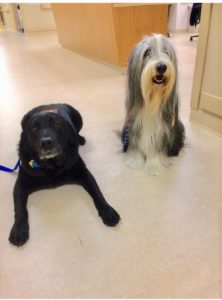
∙Larger-brained dogs outperform smaller dogs on measures of executive functions—a set of cognitive processes that are necessary for controlling and coordinating other cognitive abilities and behaviors. In particular, bigger dogs have better short-term memory and self-control than smaller ones, according to the study in Animal Cognition.
“The jury is out on why, necessarily, brain size might relate to cognition,” says lead study author Daniel Horschler, an anthropology doctoral student and member of the University of Arizona’s Arizona Canine Cognition Center. “We think of it as probably a proxy for something else going on, whether it’s the number of neurons that matters or differences in connectivity between neurons. Nobody’s really sure yet, but we’re interested in figuring out what those deeper things are.”
Canine brain size does not seem to be associated with all types of intelligence, however. Horschler found that brain size didn’t predict a dog’s performance on tests of social intelligence, which the researchers measured by testing each dog’s ability to follow human pointing gestures. It also wasn’t associated with a dog’s inferential and physical reasoning ability.
The study’s findings mirror what scientists have previously found to be true in primates—that brain size is associated with executive functioning, but not other types of intelligence.
Horschler’s study uses data from more than 7,000 purebred domestic dogs from 74 different breeds. Breed standards offered estimates of brain size.
∙By Beth Mueller
Acne plagues many teenagers and even adults, but did you know that animals get pimples too? Dr. Jason Pieper, a board-certified veterinary dermatologist at the University of Illinois Veterinary Teaching Hospital in Urbana, sees a few cases of pet acne every year.
Acne occurs when a hair follicle becomes plugged. Hair follicles lie within the skin. They cradle the root of a hair shaft, which grows out of the middle of the follicle, and supply the hair with protective oils from attached glands.
The chin is the most common location for acne in dogs and cats. Sometimes the acne can be seen around the lips and muzzle. It may appear red, brown, or black (like a blackhead), or it may look like pustules (pimples).
One theory is that the acne is a result of damage to the hair follicle, for example, when the pet drinks water from its bowl and repeatedly bumps its chin. A damaged hair follicle may become plugged with oils.
To treat acne, it is important to keep the area clean and dry. The chin and muzzle area are often wet from drinking, which can predispose that area to reoccurring acne. Pet owners can use a washcloth to gently clean the area.
New Year’s resolutions for the pet owner.
I will schedule my pet’s yearly wellness exam with her veterinarian. I will ensure that my pet remains up to date on her vaccinations and invest in another year of flea, tick and heartworm preventative for her.
I will speak with my veterinarian about the healthiest diet for my pet and work to feed him a high-quality diet. I will avoid overfeeding him, understanding that obesity in dogs and cats leads to many health problems and a reduced quality of life.
I will give my pet an informal in-home exam every month, being sure to look inside her ears, examine her eyes for discharge or other changes, lift her tail to ensure she has a clean and healthy rear end, and pet her carefully all over to check for lumps, bumps or wounds. I will contact my veterinarian promptly if I notice anything new or amiss.
I will invest in new toys for my pet. Even though he chews most of them up, I will find a way to incorporate chew toys into my budget if these are his favorite. When I cannot meet his demand for chew toys, I will invest in puzzle toys, activity feeders, bones and other enrichment items that allow him to chew and destroy without breaking the bank.
I will clean up after my pet so that her litterbox or yard is clean and free of feces.
I will practice calling my pet to come for a treat at least once a day, using a clear and happy voice and calling by name (“Fido, Come!”) I will try this from various rooms in the house and also the yard, and will practice more often if I notice he does not reliably come when called. I will remember that cats can learn to come when called, too, and will save my cat’s favorite treats or toys to be delivered when I call him to me.
REWARD LOST DOG.
XENA – Black, medium sized Shepherd mix 5 years old.
Wearing red collar with her license and tag with Xena and phone# 805-207-0235.
If you see her, please contact
Nancy Broadhead 805-207-0235
or
Cappi Patterson 805-766-5920
Vol. 12, No. 10 – Feb 13 – Feb 26, 2019 – The Pet Page
 ∙SPAN Thrift Store is providing $10 spays and neuters for low income cat and dog friends.
∙SPAN Thrift Store is providing $10 spays and neuters for low income cat and dog friends.
Three Clinics in February: Oxnard Performing Arts Center, on Saturday 23rd and Sunday 24th. Located at 800 Hobson Way, Oxnard and the third in the SPAN Thrift Store parking lot 110 N. Olive St. (behind Vons on Main) on Thursday, February 28th.
Please call to schedule an appointment 805-584-3823.
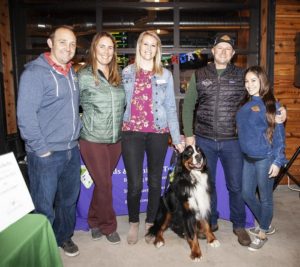
∙On Thursday, February 7, a three-year old birthday party was held for Sir Charles. The party was held at Rincon Brewery and featured music by Kirby Ali, a raffle and a special birthday cake. Charles is a Bernese Mountain Dog certified therapy dog at Kids & Families Together. Charles roams around the office and loves greeting people especially the kids who can sit on him, pull his tail and some can even ride him around.
Kids & Families Together is one of the county’s leading contractors providing services to children and families within Ventura County’s child welfare system. The not-for-profit organization was founded in January 2000 by David and Faith Friedlander, along with other passionate community members with the purpose of providing services to families that have come together through adoption, kinship care (most often grandparents raising grandchildren) and/or foster (now called resource) care.
To learn more about Kids & Families Together and support their efforts contact them at (805) 643-1446 or [email protected] and www.kidsandfamilies.org.
∙The Oxnard Performing Arts Center (The PACC) presents RESCUECON, a convention like no other, where the human-animal bond takes center stage. Through visual and performing arts, hands-on workshops, talks by inspiring individuals, an artisan marketplace, and so much more, attendees will learn, play, explore, and, above all, refresh their relationship with animals… and each other.
On February 23-24, 2019, RESCUECON sets out to promote the welfare of all animals (wildlife and farm animals too!), create a culturally-enriching environment, and provide interactive opportunities for learning, making, connecting, and relaxing. Keynote speakers include Kitten Lady (Hannah Shaw) and Ellie Laks, co-founder of the Gentle Barn. The goal of event is to rally animal lovers in the region and, in turn, strengthen the local rescue landscape.
In addition, there will be a free Adoption Fair with adoptable animals from Ventura County Animal Services (VCAS), the Bunny Brigade, Surfcat Rescue, C.A.R.L., and a $10 spay and neuter clinic provided by Simi Valley Spay & Neuter Clinic, arts and crafts, and activities for families.
A percentage of ticket sales benefits VCAS, this year’s featured nonprofit partner.
From 11AM – 5PM
General Admission $25/day | $40/weekend
Adoption Fair is Free.
800 Hobson Way, Oxnard (805) 486-2424 | oxnardperformingarts.com | rescuecon.org
Tickets are available at the box office between 12-6pm, Monday thru Saturday, by calling (805) 486-2424 or by purchase online, oxnardperformingarts.com.
∙Dog owners are urged to check their canned foods after Hill’s Pet Nutrition announced the voluntary recall of a select products because of excessive amounts of Vitamin D.
The recall notes that “the affected canned dog foods were distributed through retail pet stores and veterinary clinics nationwide” though “no dry foods, cat foods, or treats are affected.” Owners who bought the affected foods should dispose of the product and discontinue feeding it to any animals. Unopened containers may be returned to retailers.
Hill’s Pet Nutrition encourages anyone looking for more information to visit their website or call 1-800-445-5777. A list of the affected foods and the full FDA recall notice can be found here.
Though it is an essential vitamin for many functions, too much of any good thing can be harmful. According to the FDA, the danger in being exposed to high levels of vitamin D depends on the length of exposure. Symptoms include vomiting, weakness, loss of appetite, increased thirst & urination, seizures, abdominal pain, and sudden weight loss.
Humans are not the only residents of the United States who are getting fatter every year. So, unsurprisingly, are our furry friends — the dogs and cats that share our lives and, too often, our tendency to overeat.
Unlike their owners, however, the family dog or cat cannot open the refrigerator or gain access to snacks in high cupboards without human assistance, which means the responsibility for pet obesity rests with you-know-who.
Veterinarians report that nearly half the dogs they see are overweight or obese, although only 17 % of owners acknowledge that their pets are too fat.
“Others know their pet is overweight but don’t think it’s a problem,” said Deborah Linder, who heads the Tufts Obesity Clinic for Animals Clinical Nutrition Service.
According to Nationwide, the country’s largest provider of pet health insurance, obesity among dogs and cats has risen for eight years in a row, along with claims for ailments related to being overweight. In 2017, obesity-related insurance claims for veterinary expenses exceeded $69 million, a 24 % increase over the last eight years, Nationwide reported in January. With only 2 % of pets covered by insurance, the costs to owners of overweight pets is likely to be in the billions.
Vol. 12, No. 9 – Jan 30 – Feb 12, 2019 – The Pet Page
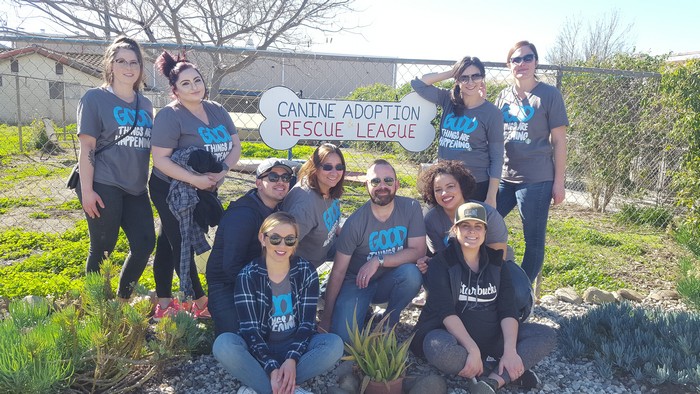
 •Starbucks completed their Community Day of Service at the CARL kennels on January 23. These strong and hard workers picked up heavy artificial turf and took it to the dumpster, sanded and painted a picnic table, pulled weeds and cut down a dead tree. Thank you, Starbucks, for picking CARL to do your Day of Service! Some of the employees may be returning to be volunteers!
•Starbucks completed their Community Day of Service at the CARL kennels on January 23. These strong and hard workers picked up heavy artificial turf and took it to the dumpster, sanded and painted a picnic table, pulled weeds and cut down a dead tree. Thank you, Starbucks, for picking CARL to do your Day of Service! Some of the employees may be returning to be volunteers!
•Animal hospital turns to underwater treadmill to help cats and dogs improve their health.
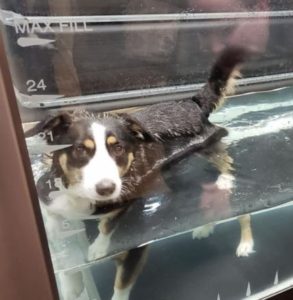
Imagine being able to give your pet the benefits of a one-hour walk with only 10 minutes of effort. It’s a concept that’s being tested by an animal hospital. The Walden Animal Hospital is home to an underwater treadmill. It’s an exercise machine on which dogs — and sometimes cats — can get a really good workout in a short amount of time. The treadmill is being used to help pets recovering from surgery, or to help them lose weight and become more active.
The Walden Animal Hospital has a water treadmill which helps dogs increase resistance, eases pressure on joints and increases circulation. Hospital staff member Lariviere says the underwater treadmill helps animals build up muscle mass, without it being pain. “The water provides resistance,” she said.
• According to a new study in the Journal of Anthropological Archaeology humans may have domesticated dogs 14,000 years ago, during the Epipaleolithic period. It was the beginning of a beautiful relationship.
The study, by archaeologists from the University of Copenhagen and University College London, looks at animal bones found in a Neolithic settlement known as Shubayqa 6, established 11,500 years ago, in the Black Desert of northeast Jordan. The bones suggest that the site’s residents were using their dogs to help them hunt which was the beginning of dog domestication. It hasn’t been clear, the researchers stated, whether that process was deliberate or accidental, but this new evidence of canine-assisted hunting implies that these Stone Age humans were highly dependent on their dogs.
At Shubayqa 6, the evidence for a hunting partnership between humans and dogs, who would’ve been more similar to wolves than the domesticated canines we know today, is written in the bones themselves. The remains bear “unmistakable signs of having passed through the digestive tract of another animal,” said lead author Lisa Yeoma and some are larger than anything even the most determined humans could shove down their gullets.
•Since the legalization of marijuana in California, cases of pets accidentally eating pot have jumped 130 percent. What should you do if your pet ingests marijuana? Get your pet to the vet immediately.
Many times, inducing vomiting is the best solution and then observation until the effects wear off. In most cases this is not life-threatening but leave the care to your vet so they can monitor their vitals.
• Armstrong Ambulance (in Arlington, MA ) EMS staff members received in-depth training from veterinarian Beth Eisenberg that would help them treat a K-9 injured in the line of duty.
EMS providers trained with a black lab to learn how to properly listen to its heart and lungs, as well as how to locate its pulse. They also learned how to provide safe transport, how to treat trauma wounds and practiced CPR on a K-9 mannequin.
“We work closely with police departments and other law enforcement agencies which includes their K-9 members, so we want to be prepared to provide critical lifesaving aid to anyone at a scene who may need it,” Armstrong CEO Richard Raymond said. “Our team members did an excellent job building an understanding of how they can provide immediate help to injured dogs just like they would with an injured person.”
• While vitamin D is “an essential nutrient for dogs … very high amounts can cause serious health problems like kidney failure or death,” the FDA said in a statement. Dog food recalls were issued after pet owners contacted the food and drug agency with reports of vitamin D toxicity in their dogs after they consumed food from some brands.
“FDA scientists have evaluated samples of some of these products, and state and private lab test results indicate that the food contained as much as approximately 70 times the intended amount of vitamin D,” the FDA added.
In severe cases, vitamin D toxicity can lead to kidney failure or even death in dogs. Those who survive may have “long-term impairments,” including kidney or heart disease, which require “life-long management,” according to VCA Animal Hospitals.
If your dog eats one of the affected brands, be on the lookout for vomiting, loss of appetite, increased thirst, weight loss, increased urination and excessive drooling — all of which are signs of vitamin D toxicity, according to the FDA.
“Pet owners should discontinue feeding these recalled products,” the FDA said, noting “the only pet products that have been impacted are food made for dogs” at this time.
Contact your vet to find out recalled products.
Vol. 12, No. 8 – Jan 16 – Jan 29, 2019 – The Pet Page
 •SPAN Thrift Store is providing $10 spays and neuters for low income cat and dog friends.
•SPAN Thrift Store is providing $10 spays and neuters for low income cat and dog friends.
Two Clinics in January: Albert H. Soliz Library – El Rio, 2820 Jourdan St., Oxnard, on Thursday, January 24th and a second one in the SPAN Thrift Store parking lot 110 N. Olive St. (behind Vons on Main) on Thursday, January 31st. Please call to schedule an appointment 805-584-3823.
•The National Police Dog Foundation is pleased to announce that as of January 1st, 2019, Peter Fehler is now the Executive Director of the Foundation.
Peter has been helping the Foundation for the last two years with marketing and fundraising. He has been instrumental in the recent growth of the Foundation and in the Foundation’s ability to improve the lives of law enforcement K-9s across the nation.
Peter has over 20 years of consulting and nonprofit growth experience. He will focus on expanding existing services and introducing new services to be offered by the Foundation.
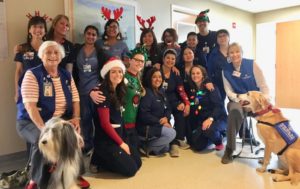
The Foundation is dedicated to providing funds and services to law enforcement K-9 units and ensuring the wellbeing of their K-9s. Their efforts assist the departments so they can safely do their jobs and protect our communities.
• Researchers at the University of California, Davis, School of Veterinary Medicine have found the genetic basis for French bulldogs and Boston terriers appearance and linked it to a rare inherited syndrome in humans.
Bulldogs, French bulldogs and Boston terriers aren’t the only dogs with short, wide heads, but they do share another feature not found in other breeds: a short, kinked tail or screwtail.
The researchers sequenced the whole genome, the entire DNA sequence, of 100 dogs, including 10 from screwtail breeds. All the participating dogs were privately owned pets seen at the UC Davis Veterinary Medical Teaching Hospital, whose owners agreed to participate.
Graduate students Tamer Mansour and Katherine Lucot, with C. Titus Brown, associate professor at the School of Veterinary Medicine and Genome Center, searched through the DNA sequences to find changes associated with screwtail breeds.
From more than 12 million individual differences they were able to identify one mutation, in a gene called DISHEVELLED 2 or DVL2. This variant was found in 100 percent of the bulldogs and French bulldogs sampled and was very common in Boston terriers.
Professor Henry Ho at the UC Davis School of Medicine studies similar genes in humans. Mutations in the related DVL1 and DVL3 genes are known to cause Robinow syndrome, a rare inherited disorder in humans characterized by strikingly similar anatomical changes — a short, wide “babyface,” short limbs and spinal deformities. In addition, Robinow patients and the screwtail breeds also share other disease traits, such as cleft palate.
In both humans and dogs, DVL genes are part of a signaling pathway called WNT involved in development of the skeleton and nervous system, among other things, said Peter Dickinson, professor of surgical and radiological sciences at the School of Veterinary Medicine. By characterizing the screwtail DVL2 protein product, Sara Konopelski, a graduate student in the Ho lab, pinpointed a key biochemical step in the WNT pathway that is disrupted by the mutation. This finding further suggests that a common molecular defect is responsible for the distinct appearances of both Robinow patients and screwtail dog breeds.
The DVL2 screwtail mutation is so common in these breeds, and so closely tied to the breed appearance, that it would be difficult to remove it by breeding, Dickinson said. Other genes are known to contribute to short, wide “brachycephalic” heads in dogs, and there are likely multiple genes that contribute both to appearance and to chronic health problems in these breeds.
Understanding a common mutation in popular dog breeds may, however, give more insight into the rare Robinow syndrome in humans. Only a few hundred cases have been documented since the syndrome was identified in 1969.
•The Food and Drug Administration has approved an anti-epileptic drug, Pexion, to treat dogs freaked out by noises (now if they could only do that for cats that get freaked out by everything).
The drug is already approved for use in treating epilepsy. Known generically as imepitoin, the drug is similar to Valium and other benzodiazepines but works in a different way to treat noise aversion. Other seizure drugs, such as gabapentin, can also treat some types of anxiety.
“Dogs with noise aversion are sensitive to loud noises such as fireworks, street/traffic noises, and gun shots,” the FDA said Tuesday.
“Dogs may show their distress through hiding; vocalizing (whining, barking, howling); panting, shaking or trembling; or may vomit, urinate or defecate. Some dogs may damage furniture, doors, dog beds, or other items in their surroundings.”
The drug was originally developed to treat epilepsy in people, but it had some troubling effects on metabolism so was never brought to market for use in humans.
Vol. 12, No. 7 – Jan 3 – Jan 15, 2019 – The Pet Page
 •SPAN Thrift Store is providing $10 spays and neuters for low income cat and dog friends.
•SPAN Thrift Store is providing $10 spays and neuters for low income cat and dog friends.
Two Clinics in January: Albert H. Soliz Library – El Rio, 2820 Jourdan St., Oxnard, on Friday, January 24th and second one in the SPAN Thrift Store parking lot 110 N. Olive St. (behind Vons on Main) on Friday, January 31st. Please call to schedule an appointment 805-584-3823.
•The Greensburg-Decatur County Animal Shelter and the American Veterinary Medical Association (AVMA) are reminding everyone to keep their pet’s safety in mind this winter season.
According to the Greensburg-Decatur County Animal Shelter when it’s cold outside a pet’s best bet for safety is indoors. Essentially, they shouldn’t be outside longer than they need to be.
Similarly, according to the AVMA, it’s a common belief that dogs and cats are more resistant than people to cold weather because of their fur, but it’s untrue. The AVMA says, like people, cats and dogs are susceptible to frostbite and hypothermia and should be kept inside, even the longer-haired and thick-coated dog breeds.
Questions regarding your pet’s tolerance for winter weather should be discussed with your veterinarian (even in Ventura). For more information on winter weather safety for pets, visit www.avma.org.
•Unusual Cases of Canine Heart Disease Linked to Boutique Diets
By Hannah Beers
Veterinarians around the world have seen a sharp rise in cases of dilated cardiomyopathy (DCM, in which the heart is enlarged and weakened) in dogs not previously recognized as predisposed to this condition. The one linking factor: a grain-free diet based on exotic ingredients.
“For the past year we have begun to notice a trend of DCM in dogs that do not typically develop DCM,” says Dr. Ryan Fries, a board-certified cardiologist at the University of Illinois Veterinary Teaching Hospital in Urbana.
Dilated cardiomyopathy is most commonly seen in large breed dogs, including Doberman Pinchers, Irish wolfhounds, and Great Danes. But recent cases have included dogs such as Boston terriers, Yorkshire terriers, and Pomeranians.
“We started looking for infections and other contributing factors, and these dogs’ diets appeared as a connection. We noticed it because the diets were so uncommon and included unusual sources of protein not frequently used in dog food,” says Dr. Fries.
As concern mounted, multiple institutions, including the University of Illinois and the Food and Drug Administration, have begun attempting to identify a reason that these particular diets would cause a cardiac issue.
“Despite a lot of testing, we have yet to identify a specific deficiency of an essential vitamin, mineral, or amino acid. There has also been no specific cardiac toxin identified. So we do not know exactly what is causing the negative cardiac effects yet,” says Dr. Fries.
One factor that appears to play a role in the problem is the size and experience of the pet food manufacturer.
“These boutique diets tend to come from smaller manufacturers that may not have the nutritional expertise and resources to ensure quality control that the larger, established companies have,” says Dr. Fries. “We are not yet seeing DCM in smaller dogs fed grain-free diets produced by large-scale manufacturers.”
There have also been multiple cases of dogs fed home-cooked diets that developed DCM.
DCM Reversal Possible with Early Intervention
In the 1980s, a similar rise in DCM developed in cats. That problem was eventually linked to commercial pet foods being deficient in taurine, an amino acid found in animal protein. So veterinarians and researchers initially thought the current cases of DCM in dogs might be due to a taurine deficiency. Low taurine levels have been documented in some dogs; however, nutritional analyses of the suspect diets and many other dogs have shown adequate levels.
“There is potential for some unknown component or lack thereof that could be affecting the dogs’ ability to absorb and use the taurine. Research is exploring those options,” says Dr. Fries.
Changing the dog’s diet and supplementing taurine has led to a reversal of the DCM in some instances. Unfortunately, the improvements may take six to twelve months to occur.
“In many of the cases, the dogs are already in heart failure by the time DCM is diagnosed. They simply do not survive long enough to respond to the therapeutic diet change,” explains Dr. Fries.
Owners should look for dog foods manufactured by large, established companies backed by scientific research, quality control, and FDA approval. These diets have years of data to back their safety and ability to meet a dog’s nutritional needs.
“Diet is an important part of any pet’s health. Make sure to bring up your pet’s diet with your veterinarian, who can help you find a safe and nutritionally appropriate food,” says Dr. Fries.
If you have any questions about boutique, exotic ingredient, grain-free foods and their link to dilated cardiomyopathy, talk to your local veterinarian.
•Multiple dry dog food brands are being recalled after the U.S. Food and Drug Administration (FDA) said they contain “toxic” levels of vitamin D, which can be deadly to dogs.
The brands include Nutrisca, Natural Life, Sportsman’s Pride and Evolve, among others. Many of the affected brands were made by the same manufacturer. Various sizes and flavors — which include chicken, lamb and rice — are subject to the recall. A full list can be found on the FDA’s website.
• A Marine veteran is crediting the Siberian husky she inherited from her Air Force son in 2011 with helping to save her life after the dog sniffed out ovarian cancer three times. Stephanie Herfel, of Wisconsin, told the Journal Sentinel that it first happened in 2013 when she noticed that the dog, named Sierra, began acting strangely when around her.
“She put her nose on my lower belly and sniffed so intently that I thought I spilled something on my clothes,” Herfel, who had been experiencing abdominal pain, told the news outlet. “She did it a second and then a third time. After the third time, Sierra went and hid. I mean hid.”
With the dog cowering in the closet, Herfel made her way to the emergency room where she was diagnosed with an ovarian cyst, but Sierra’s strange behavior pushed the 52-year-old to make an appointment with her gynecologist. A few weeks later she was diagnosed with stage 3C ovarian cancer and underwent a full hysterectomy. She lost her spleen and continued with chemotherapy until April 2014, according to the Journal Sentinel.
Vol. 12, No. 6 – Dec 19, 2018 – Jan 2, 2019 – The Pet Page
 • A thief was caught on camera stealing thousands of dollars from the CARL Thrift Store. The thief was caught on the store’s surveillance video pulling back a curtain, and going into the manager’s office repeatedly, before he leaves the store with an estimated $2,400. CARL rescues and takes in dogs that need a home, and provides them medical care.
• A thief was caught on camera stealing thousands of dollars from the CARL Thrift Store. The thief was caught on the store’s surveillance video pulling back a curtain, and going into the manager’s office repeatedly, before he leaves the store with an estimated $2,400. CARL rescues and takes in dogs that need a home, and provides them medical care.
“He basically came in and wiped everything out,” said Mary Saputo, president of the Canine Adoption and Rescue League. Our vet bills last year were in excess of $105,000. We had had a very profitable week so it was a sizeable chunk of change that he stoled” Saputo said. “This is an all-volunteer thrift shop, nobody is paid a penny and we work very hard. For this man to come in and just help himself to around $2400, that makes a difference for some little creature out there.”
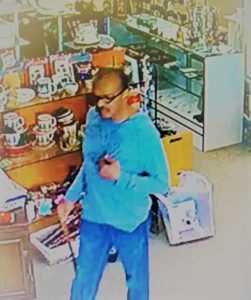
Mary came up with the idea to make up for the stolen money by holding a raffle. Two-dollars for a chance to win a $100 Petco gift card. The winning raffle number will be picked on December 23rd.
How to enter:
CARL Thrift Store 2750 E Main.
Venmo: @loveallanimals
PayPal: [email protected]
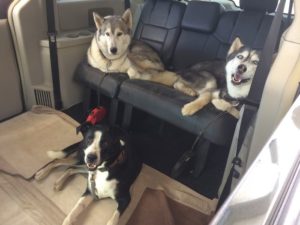
• “As we completed our trifecta to three Ojai parks, Sarzotti, Soule and Libbey, I felt my usual sense of immense gratitude for the time I get to spend with my two favorite huskies. Kai is seven and his older cousin, Jafar, is twelve. Along with my daughter’s three-year-old border collie mix, named Baker. These dogs have taught, and continue to teach me, some of my life’s most important and cherished lessons. Spending time with any of these wonders of humanity can’t help but rub off on luckypeople … like me!” Marty Kinrose – Dog Walker.
 •My Empty Lap- Remembering Buddy
•My Empty Lap- Remembering Buddy
By John Darling
I look at my lap in front of me and
My hands are the only things I see.
The warmth that was there has gone away,
So I cry knowing that the cold is here to stay.
Though many others could fill this space,
No one could ever really take your place.
I still see your eyes showing me the love
That will now only come down from up above.
No longer do I have a friend to go with me
To share in all the things I do and see
The beds you used to have everywhere
Have been given to other dogs to share
No longer do I have to buy your food
Or replace the worn out toys that you chewed
I can walk where I want without looking down
To see if you’re under my feet, dancing around
For such a little dog, you were a lot of work
Yet your kind sweet ways always made me smirk
But you’re gone now so I can do as I please
Supposedly my life will be much more at ease
Yet I will mourn for you each passing day
Wishing that it didn’t have to be this way…
 The Buddy Nation Cookbook cover girl, Candy has lost her battle with cancer. Beloved
The Buddy Nation Cookbook cover girl, Candy has lost her battle with cancer. Beloved
companion for 9 years of Richard Flores she lost her battle on November 28th. Candy was sweet
and loving right up to the end, wagging her tail and nudging for a pat or scratch.
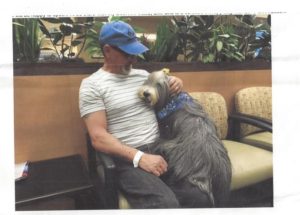 The Buddy Nation Cookbook cover girl, Candy has lost her battle with cancer. Beloved
The Buddy Nation Cookbook cover girl, Candy has lost her battle with cancer. Beloved
companion for 9 years of Richard Flores she lost her battle on November 28th. Candy was sweet
and loving right up to the end, wagging her tail and nudging for a pat or scratch.
Vol. 12, No. 5 – Dec 5 – Dec 18, 2018 – The Pet Page
 • Razzle Dazzle some cat stole your photo so please send it to us again.
• Razzle Dazzle some cat stole your photo so please send it to us again.
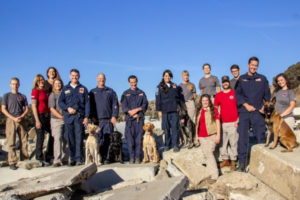
• Therapy dogs Lola, Herbie, Livi, Posey, Molli and Jock currently visit the patients and staff at CMHS twice a month. They meet at 11am in the lobby and visit patients who would like to see the dogs on the sixth floor and, if there are patients in Pediatrics on 7, they visit with them. They visit in teams of two. It brings such joy to patients, staff, families and visitors. Much more so than a human.
They represent the Dr Peter Gall Therapy Dog Program
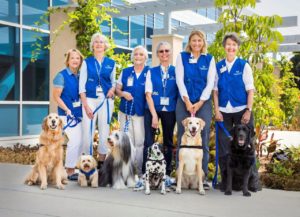
•On October 26, five new Search Teams were partnered at the National Training Center as the training team officially handed the Search Dogs’ leashes over to their new firefighter-handlers. With nearly 100 friends, family, SDF staff and volunteers in attendance, they welcomed the newest teams to the SDF family: Mike Devine & Sonny and Ryan Greenup & Koda (both with Los Angeles County Fire Department/California Task Force 2), Michael Bruce & Cooper, Imelda Cordova & Knox, both Orange County Fire Authority, and Wade Haller & Dallas of Long Beach Fire Department (all with California Task Force 5). Congratulations to the new teams and a big thank you to everyone who helped these dogs and handlers achieve this first major milestone in their careers together!
Cats and dogs may occupy similar places in people’s hearts, but when it comes to the two species’ hearts—and heart disease—there are a lot of differences. Dr. Ryan Fries, a veterinary cardiologist at the University of Illinois Veterinary Teaching Hospital in Urbana, explains some of these differences and how he is working to improve the prospects for afflicted cats.
Chronic valvular disease is the most common type of heart disease in dogs. In it, the valves degenerate and become misshapen, causing the valves to leak. Occasionally cats are born with heart valve disease, but the development of degenerative valvular disease over time, as it occurs in dogs, is not seen in cats.
Hypertrophic cardiomyopathy, on the other hand, accounts for 80 percent of cases of heart disease in domestic cats but is rare in dogs. In this disease, one or several areas of the walls of the heart become abnormally thickened.
“Certain breeds, such as Maine Coon and Ragdoll cats, are genetically predisposed to developing hypertrophic cardiomyopathy, but any cat can develop this disease,” says Dr. Fries.
Genetic tests are available for predisposed breeds to identify cats that carry the genetic mutation for hypertrophic cardiomyopathy. Cats carrying this mutation should not be bred.
Restrictive cardiomyopathy and dilated cardiomyopathy are rarely seen in cats.
“Dilated cardiomyopathy was actually very common in cats before the 1980s. Then, veterinarians discovered that dilated cardiomyopathy was linked to a taurine deficiency in commercial cat food. Now that taurine is appropriately added to cat food, this problem is quite rare in cats,” explains Dr. Fries.
Not only do the types of heart disease cats and dogs acquire differ, so do the clinical manifestations of heart disease. “Dogs almost always have an audible murmur, meaning it can be detected with a stethoscope by a veterinarian. This is not true in cats,” he says.
Radiographs (X-rays) of the chest are also commonly used to diagnose heart disease in dogs but are not as useful in cats. “We need an echocardiogram to definitively diagnose heart disease in a cat,” says Dr. Fries.
Symptoms of heart disease in cats can be subtle and non-specific. Owners may notice that their feline friends are hiding more, are less interested in the food, or generally more lethargic. Cats are masters at hiding sickness, so any changes in behavior should tip off an owner that something isn’t quite right. Cats may also show signs of respiratory distress, such as labored breathing, panting, and open-mouth breathing.
Because of changes in blood flow and enlargement of the left atrium, cats with heart disease are at increased risk for blood clot formation within the heart. Pieces of these clots may break off, being swept by the bloodstream to locations distant from the heart (thromboembolism).
The most common site for thromboembolism in cats is the back legs (saddle thrombus). This leads to acute weakness/paralysis and pain in these limbs. Cats showing signs like this should be taken to a veterinarian immediately.
“Bringing your cat for annual examinations and talking to your veterinarian when you notice any changes in your cat’s behavior are the best ways to catch heart disease at earlier stages,” recommends Dr. Fries.
“There are basically two stages of heart disease in cats, and each hold a different prognosis. In the first stage, the cat has confirmed heart disease and is at risk of developing clinical problems,” says Dr. Fries. “In the later stage, the cat has heart disease as well as clinical problems, such as heart failure or thromboembolism. An echocardiogram with a veterinary cardiologist can determine which stage a cat is in.”
“Heart health is just as vital to cats as it is to dogs, but heart disease is much more difficult to detect in cats. Regular visits to your veterinarian can help protect your cat’s heart and overall health,” says Dr. Fries.
Vol. 12, No. 4 – Nov 21 – Dec 4, 2018 – The Pet Page
 •Bio-Detection by Victoria Usher
•Bio-Detection by Victoria Usher
At the American Society of Tropical Medicine and Hygiene in New Orleans, double-blind lab tests have shown how two canines can correctly pick out the scent of children infected with malaria parasites seventy percent of the time. While all the schoolchildren appeared healthy, blood tests administered on-site discovered that thirty children were actually carrying the disease. This work is just a proof of concept, but the hope is that one day bio-detection dogs could be deployed at airports, ports of entry, or other border crossings, in order to prevent asymptomatic carriers of the parasite that causes malaria from bringing it back into areas where the disease has been eradicated.
The work was funded by a $100,000 grant from the Bill & Melinda Gates Foundation, which has made malaria a priority in recent years. In their facilities an hour outside of London, human trainers place a few drops of a standard training liquid into small glass jars. The dogs are instructed to walk down the line, pausing to sniff each one. If they stop at the new smell a trainer croons, “That’s it, good dog.” The dogs eventually learn that if they stop, sit, and point at the right jar, they will get a treat.
• Some specialist toothpastes for human-use contain ingredients which are unsafe for pets, for example xylitol, an artificial sweetener that is very poisonous to dogs. Chewable treats and bespoke dental diets aimed at preventing plaque hardening are recommended as alternatives.
More than half of the dog owners surveyed by OnePoll said they thought bad breath was normal, rather than a symptom of poor dental health. Some admitted giving their dog chewing gum when bad breath struck, while others thought a haircut would purify the scent.
There were also respondents who thought their dog’s unsavory habits might be the root cause – and sought to keep toilet lids firmly shut to stop them drinking the water.
Only a fifth of dog owners worried about bad dog breath being a sign of a serious health problem, the survey found.
Rodney Zasman, a leading London veterinary surgeon, said: “A lot of dog owners aren’t aware of how important it is to look after their dog’s dental health.”Poor care of dogs’ dental hygiene can result in complications such as dental plaque, gum disease, tooth abscesses and difficulty eating.
”Bacteria can spread from the teeth and gums causing damage to the kidneys, liver and the heart. Painful and extensive dental surgery and treatment may be needed to cure this.”
•Recently a group of Illinois veterinary students went on an unusual field trip. The board of the Human Animal Bond Association student chapter organized a trip to tour the new dog training program located at Shawnee Correctional Center (SCC) in the small town of Vienna, Ill.
SCC houses about 1800 inmates and is a medium to maximum security prison. The program called SWATT, or Shawnee Wellness Assistance Therapy Training, was started in March, 2018 and is run by Angela Galbraith in conjunction with Project Hope Humane Society of Metropolis, Ill., which supplies the dogs and the funding for their care.
A unique feature of SWATT is that, while the program helps both the inmates and the dogs, it also helps our U.S. veterans. When the dogs graduate the training program at the correctional center, they are given, free of charge, to veterans who have applied to adopt them.
The dogs receive basic obedience training from the inmates with the assistance of a professional dog trainer, who donates her services to the prison. The dogs receive their Canine Good Citizen Ready certificate and then are ready for advanced training, which involves more specialized skills and varies according to the needs of their future owners.
The dogs are taught about wheelchairs and how to properly approach people in them. They are taught about navigating stairs and elevators or retrieving items. Also, during their stay in the prison, the dogs are brought out to local veterans’ events to help acclimate them to different social situations. They visit the VA homes and attend local parades. Angela said the veterans just love when the dogs visit; the visits really brighten their day.
•A woman who bred and sold sick puppies from her Plainfield home to people across New Jersey will never own a pet in the state again, under a sentence handed down.
Suzie Bourdouvales, 38, pled guilty to two counts of third-degree animal cruelty and was sentenced to probation. She was barred for life from owning, breeding, or selling pets in New Jersey.
The New Jersey SPCA and the prosecutor’s office searched her home after a yearlong investigation and seized 19 puppies of “varying ages and medical states” that were living in “unsafe and unsanitary conditions,” Union County Assistant Prosecutor Patricia Cronin said in the release.
Authorities said Bourdouvales had hoarded dozens of sick puppies, many of which died under her care.
Many of the dogs she sold died despite their new owners’ desperate attempts to save them, officials said.
This was not her first time selling sick animals. She previously pled guilty to selling them out of her car in Plainfield in 2015, and she was ordered to pay nearly $20,000 in restitution, the prosecutor’s office said.
The dogs seized from her home were placed into the care of the Cranford-based Best Friend Dog and Animal Adoption and Traveling Paws Animal Rescue, as well as Brendan’s Meadows Rescue in Mountainside.
Bourdouvales must also pay over $30,000 in restitution to her customers, undergo a psychological evaluation, comply with all ordered treatment, and submit to periodic monitoring.
R.I.P. Ethel
2002-2018
Ethel was half of a pair of Siamese sisters – her twin being Lucy (of course). Ethel was a cross-eyed little bundle of fun and the loved and loving companion of Jane Van Note for all of her sixteen years. She will be deeply missed by Jane, Lucy, Copper, Jack, Charlie, Princess, Orange, Alice, Taz and Cappi
Vol. 12, No. 3 – Nov 7 – Nov 20, 2018 – The Pet Page
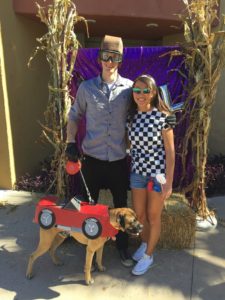
• A correction to the photo and caption published in the Nov. 6th Ventura Breeze. The two that tied for Best in Show at the Ventura Harbor Village Howl-O-Ween dog costume contest were the train with the conductor and # 26 the race car dog. The later was to the right of the train and not shown in the picture published. the dog’s name is Turbo, pictured with his owner Michael DiGiulio and girlfriend Jia Wiebe.
• Can dogs help us figure out cancer?
Two recent articles published in the journal Breast Cancer Research and Treatment suggest that man’s best friend could light the path towards fighting cancer.
A team of researchers from across Europe have found that canine breast cancer remarkably resembles human breast cancer, suggesting that treatments effective on dogs could be as beneficial to their owners.
In the two related studies, researchers from France, Spain, Portugal, and Germany studied 350 dogs of various breeds with breast cancer. The first article details how factors used in human prognosis—tumor size, lymph node malignancy, kidney function, and other criteria—were applied to dogs with mastectomies, successfully predicting their survival rates.
The second study examines how chemical analysis, which is common in human diagnosis, applies to canine cancer cells. Researchers here discovered that more than three-fourths of those dogs developed an especially aggressive type of breast cancer for which there is currently no targeted treatment.
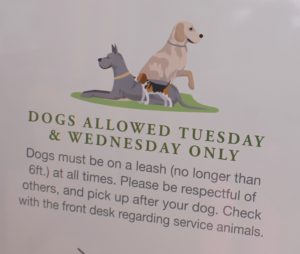
•Researchers at an Ontario university have used 3D-printing technology to replace the majority of a dog’s cancer-ridden skull, a novel procedure they say marks a major advancement in veterinary medicine.
Michelle Oblak, a veterinary surgical oncologist with the University of Guelph’s Ontario Veterinary College, said she believes the procedure is the first of its kind in North America and a substantive leap from one other known case. “Our hope is this is something that could be more widely available on a broad scale,” Oblak said. “It went very well.”
Patches, the nine-year-old dachshund at the center of the procedure, had a brain tumor the size of an orange that grew through her skull and would have been fatal if not treated.
“We called her our little unicorn because she had this bump on her head, but it would have killed her,” said Danielle Dymeck, who is from Willamsport, Pa. “It’s pretty amazing what they did for my girl.”
• By Dr. Celeste Conn who has a house call practice in Kent County. Visit her website at thevisitingvet.net.
My pets don’t brush their teeth every day. Do yours? Probably not.
While the best current advice is for owners to fulfill this task daily for our animals, my guess is few do.
Veterinarians routinely advise daily tooth brushing, advanced at-home care and routine hospital cleanings.
Just why is dental care so important? Obviously, we don’t brush teeth so dogs have nice white smiles. We perform home care for the same reason humans do — to minimize bacterial buildup on the tooth surface and to decrease plaque formation.
Plaque is a combination of bacteria, chemicals from saliva and food bits, which when not removed, accumulate to form a hard deposit on the tooth surface. Plaque can mineralize into tartar in a scant 36 hours.
Tartar, or calculus, can cut into the gum line, extending to the part of the tooth hidden under the gum. It can push the gum away from the tooth surface, allowing a pocket to form which accumulates more bacteria, food particles and debris. That’s why daily brushing is recommended-to stop the cascade.
Tooth decay, halitosis (bad breath), then bone loss occurs around a diseased tooth. It happens because the attachment of the tooth to the socket it sits in is lost.
The rules for good oral health are the same, whether dog, cat or human. Daily brushing, using a soft brush certainly helps to prevent plaque from becoming tartar. And there are animal-specific toothpastes which are not harmful if swallowed.
Animal pastes do not form suds like ours do and are flavored to increase acceptance. Dental rinses, treats and diets contribute to good oral health too.
Dental diets, which are veterinary prescription products, act to physically abrade tartar from the tooth surface by virtue of their large size and honeycomb architecture. Dental treats often use chemical means to scrub off plaque and encourage chewing.
Because in-hospital dental cleaning must be performed under anesthesia, animals need blood work to ensure their major organs can tolerate sedation. The frequency with which the procedure is done varies from pet to pet. Small breed dogs often require yearly or even biannual cleanings whereas larger breed dogs whose teeth are not so crowded may go several years between. Whether animals eat canned or dry food can also influence frequency.
Neglecting an animal’s oral hygiene has significant impact on his or her overall health. Bacteria from a diseased mouth can easily spread to other parts of the body. The valves of the heart are a notorious target for bacterial contamination as are the filtering cells of the kidney. Owners and veterinarians can and should work together to keep pets healthier through good dental care.
